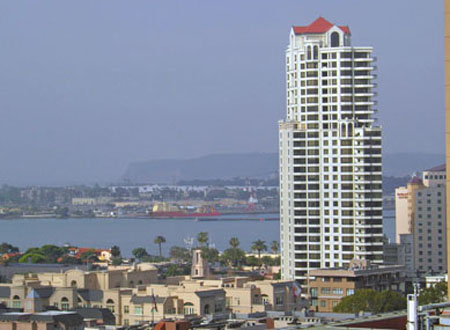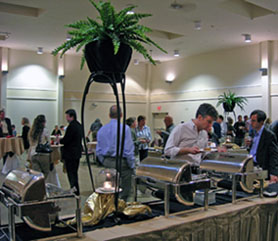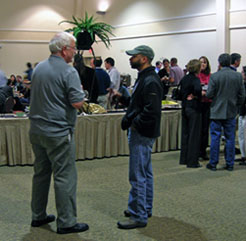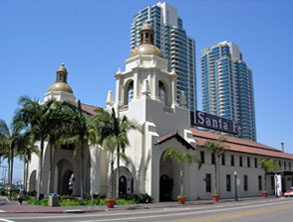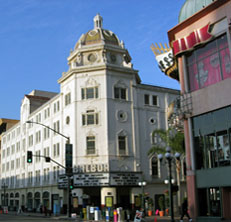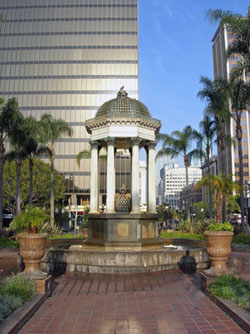|
DIGITAL LIBRARY FEDERATION SPRING FORUM SAN DIEGO APRIL 13-15, 2005
Westin Horton Plaza PRECONFERENCE: TUESDAY, APRIL 12 9:00am—5:00pm METS Editorial Board Meeting—by Invitation Only (Library, Lobby Level) 9:00am—5:00pm The California Digital Library (CDL) American West Project Meeting—by Invitation Only (Coronado, Third Level) DAY ONE: WEDNESDAY, APRIL 13 10:00am—12:30pm METS Editorial Board Controlled Vocabulary Meeting—by Invitation Only (Plaza Room B, Second Level) 10:00am—12:00pm The Digital Library Federation (DLF) OAI Focus Group Meeting—by Invitation Only (Plaza Room C, Second Level) 12:00pm—1:00pm Registration (Second Level, Top of Stairs) 1:00pm—2:10pm Keynote Address: Technology and the Professorate. Edward Ayers, Dean, College of Arts and Sciences, University of Virginia (California Ballrooms A and B, Second Level) 2:10pm—2:30pm Break (California Foyer, Second Level) 2:30pm—4:00pm Session 1: METS PROFILES (California Ballroom A, Second Level) Making METS Profiles Machine-Actionable to Support Validation and Facilitate Interoperability. Corey Keith, Library of Congress Until now METS profiles have existed in prosaic form guiding the user in creating conforming METS documents. The METS Profile schema serves as a standardized container for this information but due to its form it must be interpreted by a human to derive any benefit. The Library of Congress has created an XML-based, machine-readable scheme to express profile requirements. This scheme goes beyond the grammar-based METS schema to express structural requirements, relationships between elements, and profile-required metadata elements. Expressing requirements in this form enables the development of generic profile-aware tools. The Library of Congress has developed a prototype of an obvious example of such a tool: a METS profile validation tool. Profile validation can be reused within the institution, but more importantly it facilitates interoperable exchange of METS documents between institutions by enforcing the profile contract. Senders can validate their METS documents before dissemination and receivers can validate before ingestion and be sure of the conformance to the profile specification. The presentation will also discuss other uses for machine-actionable METS profiles including input/editing tools and dissemination systems. Creating METS Profiles Using METS and MODS. Morgan Cundiff, Library of Congress The Library of Congress has created a set of METS Profiles for various document types including musical scores and parts, sheet music, phonodiscs, compact discs, photographs, print materials, recorded events, and bibliographic records. The profiles were created for use with the Library's digital library application called "I Hear America Singing" ( http://www.loc.gov/rr/perform/ihas/), but are intended to be generally useful to the digital library community. It is further intended that the profiles be used as a basis for interoperation between applications and digital archives. The profiles make use of METS and MODS together to express both the logical hierarchy and the physical hierarchy of given object types. Further, the profiles are also intended to serve as a first step toward the creation of profile-aware software tools. 2:30pm—4:00pm Session 2: REPOSITORIES AND SERVICES (California Ballroom B, Second Level) A Technology Analysis of Repositories and Services. Sayeed Choudhury and Tim DiLauro, Johns Hopkins University The concept of the institutional repository has gained traction within the digital library community. While this idea provides a useful description that may facilitate institutional adoption, it may also oversimplify the complete picture associated with digital library architecture. Institutions may now be finding that there will be multiple repositories and applications in the same environment. At Johns Hopkins University, we are promoting the idea that applications should access repositories through an abstract, repository agnostic layer, rather than through custom application to repository integrations. With funding from the Mellon Foundation, Johns Hopkins will evaluate repository software and a range of services. The result of this evaluation will be a set of best practices, recommendations, and functional requirements for repositories and applications. This project reflects our belief that content should reside in multiple repositories external to applications, so that the same content can be used by several systems and support multiple services. This concept will be tested with content that is moved through repositories into applications as defined against a set of use cases that reflect various services. Specific examples we are considering include digital preservation (e.g., Archive Ingest Handling Test), e-learning (e.g., Sakai), and e-publishing (e.g., Project Muse). UVA Library Repository Interface and Tool Evaluation. Leslie Johnston, Director of Digital access Services, University of Virginia Library In fall 2004, the University of Virginia Library launched its Central Digital Repository for its first experimental year. The Repository includes a digital image collection, electronic text collection, and EAD Finding Aids for the UVa Library's Special Collections. The Repository itself was built using Fedora, a digital library management architecture jointly developed by the University of Virginia and Cornell University. The interface was built using Cocoon, XPAT, JavaScript, and Web Standards-compliant XHTML and CSS. The interface was designed to accommodate discovery and delivery of objects across collections and formats—images, texts, finding aids—and provide access to tools that support use of the collections in research and instruction. This includes an Image Viewer for on-the-fly manipulation of images, and a Digital Object Collector Tool for the creation of personal collection portfolios, slide shows, and image reserve Web sites. The interface and tools will be briefly demonstrated. The development of the interface and tools required an extensive internal design review, where every element on every screen was scrutinized for consistency and proper functionality in a number of browsers for Wintel PCs and Macintosh. The interface is currently undergoing task-based usability testing with library staff and faculty. A group of six faculty members are also currently testing both the interface and the tools in the teaching of six courses, ranging from undergraduate courses to graduate seminars to design studios. Testing procedures and examples of test results and changes made to the interface and tools will be presented. The Bibliotheca Alexandrina Digital Library: Services and Repository-Building. Noha Adly, ICT and ISIS Director, Bibliotheca Alexandrina
This presentation will begin with a brief overview of the
projects Bibliotheca Alexandrina is undertaking towards building
a digital library, including the Internet Archive, the Million
Book project, and the digital preservation of the modern history
of Egypt.
4:00pm—4:30pm Break (California Foyer, Second Level) 4:30pm—6:00pm Session 3: INTEGRATING DIGITAL LIBRARIES (California Ballroom A, Second Level) The DLF Aquifer Initiative: A Progress Report. Katherine Kott. Aquifer Director, The Digital Library Federation. DLF Aquifer emerged as the re-awakened strategic direction of the Distributed Open Digital Library initiative of the Digital Library Federation in May 2003. According to the original 1995 Digital Library Federation mission statement, the DLF was established to �bring together -- from across the nation and beyond -- digitized materials that will be made accessible to students, scholars, and citizens everywhere, and that document the building and dynamics of America's heritage and cultures.� DLF has progressed towards this strategic goal since its inception through support, coordination and participation in the development of prototypes, proofs of concept and test-beds that will form the foundation of DLF Aquifer. This project briefing will review the status of the DLF initiatives upon which DLF Aquifer is being built and outline the project plan for the coming year. The update will focus on organizing for collaboration, leveraging existing collections and technical developments and defining the DLF Aquifer problem space. Integrating Digital Libraries: Teaching, Learning, and Publishing in the DART Project. Gordon Dahlquist, Brian Hoffman, and David Millman, Columbia University The Digital Anthropology Resources for Teaching (DART) project integrates the content acquisition and cataloging initiatives of a federated digital repository with the development of scholarly publications and the creation of digital tools to facilitate classroom teaching, a union between the traditional perspectives of the library and the scholarly publisher. While the focus of the existing repository is in the field of anthropology, the DART model presents a practical methodology to combine repository and publication that is both exportable and discipline-neutral. The scope of the digital repository is established by area librarians and scholars, who work with editorial staff to curate content selection, describe hierarchies, rights, provenance, and other metadata, and utilizes harvesting protocols such as OAI-PMH to acquire targeted records and resources. The project then employs postdoctoral teaching Fellows, working within the EPIC publishing environment with editorial and technical staff, to apply teaching-related metadata, annotation, text, etc. to repository material to create self-contained digital teaching tools such as online syllabi, complex learning objects, and curriculum models. Because these teaching tools emerge from and retain links back to the larger DART repository, students are introduced to a specific context within a given learning object, while remaining free to examine those same resources within the unconstrained context of the entire collection. This unique combination puts students into a relationship where they benefit from the added value of editorial and pedagogical structure without sacrificing the unfiltered access to a traditional library collection crucial to their own independent research. Because these publications and learning objects emerge from and lead back into the larger collection, DART offers an environment where undergraduates are given the ability to make the transition to graduate-level research methods in a way not available in most (digital or non-digital) secondary-source learning materials. 4.30pm-6.00pm Session 4: FACULTY-LIBRARY COLLABORATIONS IN BUILDING DIGITAL COLLECTIONS (California Ballroom B, Second Level)
Oya Y. Rieger, Director, Digital Library and Information Technologies, Cornell University Library, Moderator
There are several initiatives among DLF members to promote library-faculty partnerships in creating digital collections. The goal of this presentation is to discuss the technical, financial, organizational, and policy issues brought up by these collaborations, which are different than internal digitization projects. Issues of rights, standards, workflows, and different terminologies and expectations can pose significant challenges for the participants of such initiatives. This forum will bring together representatives from three libraries with faculty initiatives to compare and discuss experiences and best practices that are emerging in support of such programs. After a brief introduction by the panel organizer, there will be presentations by the panelists based on a standard set of questions. The goal is to offer a structured presentation to allow comparison of institutional policies and practices on issues such as service frameworks, financial aspects such as per image costs, standards implementation, promotion of the initiatives, lessons learned, rights management challenges, integration of these collections with internal projects, etc. 7:00pm—10:00pm Reception (Garden Pavilion and Terrace, Fourth Level)
DAY TWO: THURSDAY, APRIL 14 8:00am—9:00am Breakfast (Garden Pavilion, Fourth Level) 9:00am—10:30am Session 5: DIGITAL LIBRARIES, DIGITAL COMMONS, AND THE DIGITAL LIBRARY OF THE COMMONS (California Ballroom A, Second Level)
Charlotte Hess, Director, Digital Library of the Commons, Indiana University: presentation
Charlotte Hess: "The Digital Library of the Commons: From Theory to Practice"— "Commons" are generally thought of as resources jointly shared by a group of people. In a commons, the groups can be small (the family refrigerator) or community-level (sidewalks, playgrounds, libraries, etc.), or very large, at the international and global levels (deep-sea oceans, the atmosphere, the Internet, and scientific knowledge). The commons can be well-bounded (community forests, irrigation systems, libraries); trans-boundary (Danube River, migrating wildlife, the Internet); or without clear boundaries (knowledge, the ozone layer). The unifying thread in all commons resources is that they are jointly used, managed by groups of varying sizes and interests. Core to all commons are issues of collective action, equity, and sustainability. The Digital Library of the Commons (DLC), as a global repository, is itself a "commons" serving as a gateway to the scholarly literature on the commons and common-pool resources (CPRs). The DLC uses open-source software and is OAI-compliant. It contains over 1,100 full-text articles, conference papers, working papers, and dissertations. In addition to offering a self-publication portal, it contains other services, such as an advanced searching and browsing mechanism, a comprehensive, searchable bibliography, and a specialized keyword thesaurus. This presentation will focus on the institutional design of the DLC in order serve an international, interdisciplinary community of students, scholars, practitioners, and policymakers interested in questions of effective resource management and sustainability. Andy Revelle: "Uncommon Findings on Users of the Commons"—This presentation represents an informal assessment of the users and usage of the Digital Library of the Commons (DLC). The study employs both transaction log analysis and experiences working with users. It begins by presenting a profile of the DLC users, who are an international and interdisciplinary cohort of scholars, development-agency workers, and others concerned with the myriad of issues related to common-pool resources and the commons. This geographical and institutional variety represents a striking difference from the users of other self-archiving digital library collections, who tend to share institutional and/or academic affiliation. I discuss some issues presented by this diverse user group, most notably low user bandwidth and matters related to academic terminology and keyword classification. The presentation continues by discussing system usage. One function of the DLC is as a repository for papers presented at conferences related to common pool resources. We have observed a positive correlation between the number of hits and user submissions, and the posting of conference papers. I argue that this represents a possible solution for self-archiving repositories faced with low numbers of submissions. John A. Walsh: "The Technological Growth of the Digital Library of the Commons"— The Digital Library of the Commons (DLC) has been, in many ways, a first for the Indiana University Digital Library Program. It was one of our first partnerships with a research center, in this case the Workshop in Political Theory and Policy Analysis (http://www.indiana.edu/~workshop/), and our first experience with self-archiving technologies. The DLC was originally and briefly developed on the IBM Content Manager platform. With the arrival of EPrints (http://www.eprints.org/)—the fist widely implemented, open-source self-archiving platform—we migrated to the Eprints solution. Since then, we have upgraded from Eprints 1.x to 2.x and have gradually integrated into the EPrints-based site's additional features and functionality, including a searchable bibliography on literature of the commons, a linked keyword thesaurus, and full-text searching of the EPrints archive. My talk outlines the development of the Digital Library of the Commons, our experiences working with EPrints's self-archiving software, and our efforts to integrate additional features, beyond out-of-the-box EPrints functionality. 9:00am—10:30am Session 6: FASTEN YOUR SEATBELTS: WE ARE APPROACHING A PERIOD OF TURBULENCE . . . (California Ballroom B, Second Level)
Ann Okerson, Associate University Librarian for Collections and Technical Services, Yale University, Moderator
The digital revolution is so 90s! We have accomplished much but have done so inside a now stable and predictable paradigm: online resources that look a lot like their artifactual equivalents, accessed through an OPAC, searched with search engines that improve their functionality by working more and more like print systems squeezed through a 1950 issue of Popular Science (making footnotes active links, incorporating illustrations that turn out to be animated), and all using computers of a size, shape, and brand of operating system that we've been familiar with for at least a decade. The premise of this session is that it's good to be reminded of the turbulence ahead so that libraries will be prepared to address it adequately. Mark Sandler will take us to the Google Print construction site to think about what happens when the real science fiction transformation of print in the spirit of Vannevar Bush happens and every book potentially becomes available online. Joseph Esposito will take us to a world beyond today's electronic journals, those publications we love to hate, and will imagine for us the post-journal culture in all its creative glory, while asking the question, what would we create today if we did not know journals? Bernard Frischer will lift us off the page into the third dimension—a dimension we will access away from our comfortable desks and traditional monitors. Your life preserver is under your seat or in the armrest. 10:30am—11:00am Break (California Foyer, Second Level) 11:00am—12:30pm Session 7: NEW USER SERVICES (California Ballroom A, Second Level) In Search of the Single Search Box: Building a "First-step" Library Search Tool. : video demo Tito Sierra and Steve Morris, North Carolina State University Libraries are under increasing pressure to provide users with a single search box that provides access to the diverse set of content and services available through the library website. Neither library catalogs nor generic Web site search tools meet this need directly. Metasearch, while promising, is still generally characterized by slowness, incompleteness in coverage, and confusing result sets. At NC State, an analysis of library Web site search logs indicated that a large percentage of user-submitted search terms target similar classes of content (e.g., database names, journal titles, library information) to which the library could readily provide a direct link. Concurrent with implementing a next generation metasearch tool, NCSU Libraries is developing a new Web site search tool designed to provide users with quick and comfortable access to distributed silos of library content. A "sponsored-links" component of this tool connects users to relevant high-use library resources and information. A subject- identification component provides contextual links to subject resource guides. Integrated results from ancillary local indexes enable use of the tool as a "first-step" in library search. This presentation will describe an in-house solution based on open source tools such as Nutch and SWISH-E. Challenges of current development will be discussed and future development directions will be outlined. docWORKS/METAe: Automated Conversion of Printed Materials into METS/ALTO Objects Claus Gravenhorst and Daniel Lanz, CCS Content Conversion Specialists. 11:00am—12:30pm Session 8: COLLABORATIVE SERVICES (California Ballroom B, Second Level) Southern Spaces: A Collaborative Model for Open Source Scholarly Publishing Katherine Skinner, Emory University This presentation will provide an overview of the intensive collaboration between librarians and scholars that has produced the peer-reviewed internet journal, Southern Spaces (www.southernspaces.org). It will consider the viability and sustainability of the model Southern Spaces offers of born digital, library-supported publishing. Recent advances in digital technologies have fostered new forms of information exchange that have significant implications for the field of scholarly publishing. Although various internet publishing models, including born print and born digital, have been tested by scholarly presses, society presses, and commercial entities, no institutionalized form of scholarly e-publishing has emerged to date. Further, although libraries have subscribed to, and sometimes even hosted, many of these new e-publication forms, few libraries have participated collaboratively in the creation and maintenance of internet-based publications. Emory University's MetaScholar Initiative pioneered a collaborative model for library-based e-publishing by bringing together librarians and scholars to design and implement a born digital, open access publication, Southern Spaces. This peer-reviewed internet journal and scholarly forum seeks to expand the potentials of scholarly publication in two seminal ways. First, it reexamines the relationship between form and content, pushing scholarship toward new multimedia explorations of topics that cannot be managed in traditional print formats. Second, it explores the possibility of the library taking on a new role as a publishing center for scholarly work. This presentation will encourage discussion of the feasibility of fostering and supporting such open access journals as digital library initiatives. Creating an Online Library of Map and Geospatial Data: Challenges and Opportunities Tsering W. Shawa, Princeton University This presentation will share how we designed a system that allows us to manage, store, and make scanned maps, aerial photographs, satellite images, and geospatial data accessible online. The system was designed using off-the-shelf commercial software packages such as ESRI's ArcCatalog, ArcIMS, and ArcSDE, Mapping Science's GeoJP2 Image Server, Encoder and Decoder, Microsoft's SQL Server database, and Safe Company's SpatialDirect and FME. The presentation will not only discuss how and why we designed this special system architecture but also how we developed our workflows, what standards we used in creating metadata, scanning maps, and compressing images using JPEG2000 technology, and what lessons we learned from designing this complex system. 12:30pm—2:30pm Break for Lunch (Individual Choice)
2:30pm—4:00pm Session 9: ADVANCES IN SHAREABLE METADATA AND WEB SERVICES (California Ballroom A, Second Level) Best Practices for OAI Data Provider Implementations and Shareable Metadata: A DLF Initiative
Kat Hagedorn, University of Michigan
The Open Archives Initiative Protocol for Metadata Harvesting (OAI-PMH) has been widely adopted since its inception in 2001; there are currently over 500 active 2.0 data providers from a wide variety of domains and institution types. The protocol has demonstrated its usefulness as a tool to move and aggregate metadata from diverse institutions. The first phase of the Digital Library Federation's Aquifer project will include an OAI-based repository for metadata harvested from participating DLF members. However, as the protocol has become more widely adopted, several broad areas of concern have surfaced—mainly through the documentation of service providers—that would benefit from the establishment of best practices. In the summer of 2004 a group of DLF and NSDL affiliated OAI data and service providers began work on a set of best practices for both data and service providers. These cover implementation practices to be encouraged among data and service provider groups; communication both among and between data and service providers; and the optimization of shareable metadata. This talk will present the completed drafts of two sections of the OAI Best Practices work—OAI data provider implementations and shareable metadata—to the DLF membership. We will briefly discuss the process of creating the best practices, highlights from these two sections, and discuss next steps in the process, including the need to operationalize the best practices through development of tool sets and implementation within commercial and open source content management systems. We will offer an opportunity for feedback and discussion. Ockham Update. Jeremy Frumkin, Oregon State University The OCKHAM Initiative is a collaborative effort to promote interoperability among digital library services. Sponsored by the Digital Library Federation, the initiative is currently working on a funded NSF/NSDL grant to build a digital library services registry, and a suite of digital library services. This presentation will consist of an overview of the initiative, a detailed look at the digital library services registry, and a close look at the digital library services developed by the project. 2:20pm—4:00pm Session 10: LOCKSS AND THE HUMANITIES (California Ballroom B, Second Level)
Tom Robertson, Assistant Director and Technical Manager, LOCKSS Program: presentation
In February 2004, 13 institutions met and agreed to collaborate on a project to collect and preserve important, born digital, freely available humanities e-journals using the LOCKSS system. These 13 institutions (and others) are contributing time from a technical person, time from a collection development person, and a LOCKSS computer:
To date the group has identified hundreds of titles. The quality of these at-risk e-journals is such that most research libraries would have them, if they were available on paper. In many cases their use of multimedia and animation make paper versions impossible. As titles from this project are released for preservation, they are listed http://lockss.stanford.edu/about/titles.htm The group has experience with the efficacy and efficiency of using the LOCKSS system to build born digital, open access, humanities e-journals collections. Specifically we have experience: selecting titles; obtaining publisher permission; developing software; collecting; and preserving the content. This cooperative collection development model may be applicable to other subjects with important collections of born digital and open access content. The speakers will address, from their perspective: reasons for participation; processes and procedures to date; and early key insights. We've chosen to have more than the usual number of speakers - and to have each person speak briefly (10 minutes) to underscore the community and collaborative nature of this work.
4.00pm-4.30pm Break (California Foyer, Second Level) 4.30pm-6.00pm BIRDS OF A FEATHER SESSIONS 1) Digital Library Education (Coronado, Third Level) Kristine
Brancolini, Digital Library Program, Indiana University
In October 2004 Indiana University and University of Illinois Urbana Champaign began an IMLS-funded project to create two research-based curricula at our respective schools of library and information science to prepare librarians for work in digital library programs in libraries, archives, and museums. "Building an Effective Library Curriculum through Library School and Academic Partnerships" builds upon the experience of the digital library programs at these universities and the desire on the part of their library schools to learn from practitioners. Many library schools offer "digital library" courses, but how well do library school courses synchronize with the knowledge and skills actually needed by librarians who work in digital library programs? To be successful we must engage in discussions with librarians from many different digital library settings. The Digital Library Federation Forum offers a perfect opportunity for interacting with these librarians. At the spring forum in San Diego we would like to have a more informal discussion with others who might be interested in this topic. We would give a brief overview of our results to date, but the real purpose would be discussion with librarians from all levels of experience. Our project also includes paid and unpaid internships. In addition to discussing education for digital librarianship in general, we would also like to get a sense of other institutions that might be willing to supervise interns from our new program, which will be launched in fall 2005. For more information about our project, please see the project web site: http://lair.indiana.edu/research/dlib/index.php 2) Preservation Metadata (Harbor A, Third Level) Rebecca Guenther, Library of Congress, Priscilla Caplan, University of Florida, and Brian LaVoie, OCLC. A discussion of recent advances in the area of preservation metadata. By the time of the Forum the PREMIS preservation metadata element set and data dictionary will have been in public circulation for more than a month. This would be a good time to start a new discussion about where we are with preservation metadata, how it is being implemented and managed at different institutions, and what the next steps should be to move forward in this area. Topics which might be discussed at the BOF could include, but would certainly not be limited to, the potential for formal standards-building in this area; opportunities for collaborative creation and sharing of preservation metadata across repositories; automated tools; and the role of registries in supporting maintenance of certain forms of preservation metadata. 3) OAI Best Practices (Harbor B, Third Level) Sarah Shreeves, University of Illinois at Urbana-Champaign The Open Archives Initiative Protocol for Metadata Harvesting (OAI-PMH) has been widely adopted since its inception in 2001; there are currently over 500 active data providers from a wide variety of domains and institution types. The protocol has demonstrated its usefulness as a tool to move and aggregate metadata from diverse institutions. However, as the protocol has become more widely adopted, several areas of concern have surfaced that would benefit from documentation of best practices. This session will be a discussion of the work of a DLF convened group to develop best practices for OAI data and service providers, particularly on two sections on 1) the implementation of OAI data providers and 2) shareable metadata. We encourage participants to actively share their concerns, questions, and ideas on these guidelines. 4) Digital Imaging (Balboa, Third Level)
Clay Redding, Princeton University
Digital imaging and related technologies. Topics include:
DAY THREE: FRIDAY, APRIL 15
8:00am—9:00am Breakfast (Garden Pavilion, Fourth Level) 9:00am—10:30am Session 11: THE NATIONAL DIGITAL PRESERVATION PROGRAM (NDIIPP): DLF INSTITUTIONAL PARTICIPATION (California Ballroom A, Second Level)
Martin Halbert Emory University, Moderator
This panel will include a brief introductory recap of the NDIIPP, as well as brief presentations by DLF institutions participating in the program concerning the goals of the cooperative projects they are leading. 9:00am—10:30am Session 12: DIGITAL LIBRARY GRID INITIATIVES. (California Ballroom B, Second Level)
MacKenzie Smith, MIT, Moderator
The panel will describe several important projects which are working on applications of the computational grid (http://www.globus.org/) and the data grid (http://www.sdsc.edu/srb/) to the digital library and archives domain. Three presentations will review current projects and discuss their relevance to the future of digital library developments. The three presentations will include:
Each of these projects is looking at some aspect of digital library work, either in the discovery process (e.g., Cheshire) or the digital library arena (e.g., DSpace) or the digital archives arena (e.g., the persistent archive prototype), and all are working with SRB and related grid tools to accomplish this. By including this range of grid-based projects the panel will outline a roadmap for how grid technology might affect digital library work over the next five to ten years. 10:30am—11:00am Break (California Foyer, Second Level) 11:00am—12:30pm Session 13: NEW PROVIDER SERVICES (California Ballroom A, Second Level) METS Navigator: A METS-based Display and Navigation Utility for Multi-Part Digital Objects.
John Walsh, Associate Director for Projects and Services, Indiana University Digital Library Program
The presentation will discuss METS Navigator, a METS-based system for displaying and navigating multi-image digital objects. Using the information in the METS <structMap> elements, METS Navigator builds a hierarchical menu that allows users to navigate to specific sections of a document, such as title page, specific chapters, illustrations, etc. METS Navigator also allows simple navigation to the next, previous, first, and last page image or component part of a digital object. METS Navigator also makes use of the descriptive metadata in the METS document to populate the interface with basic descriptive information about the digital object. METS Navigator was initially developed by the Indiana University Digital Library Program for the online display and navigation of brittle books digitized by the IU Libraries' E. Lingle Craig Preservation Laboratory. However, realizing the need for such a tool across a wide range of digital library projects and applications, we designed the system to be generalizable and configurable. We have also designed METS Navigator with the goal of eventual release as a free open source utility for the wider digital library community. Our presentation will trace the development of METS Navigator, demonstrate the METS Navigator system, review METS Navigator configuration options, and outline plans for future development. METS Navigator is built using Java and open source Web technologies, including the Apache Struts Web Application Framework, the Castor Java & XML Data Binding libraries, and Ant, and runs under a Web application server such as Apache Tomcat. Steve Toub, Web Design Manager, The California Digital Library Among other activities, the California Digital Library (CDL) provides site-building tools to digital libraries. CDL's Interface Customization Tools were first released in April 2004. At present, several service providers are using this set of templates and documentation in conjunction with CDL's XML gateway to provide branded interfaces for the subset of content they have submitted to CDL's repository. CDL is expanding this set of templates and documentation to allow its customers to be able to "skin and slice" TEI-encoded texts and EAD-encoded finding aids; this new system works in parallel with the new Lucene-based platform for searching and displaying well-formed XML: eXtensible Text Framework (XTF), which was introduced at the Fall 2004 DLF Forum. In addition to illustrating how the XSLT-based customization tools work, the presenter will cover lessons learned, current development, and future plans including:
11:00am—12:30pm Session 14: NEW CHALLENGES IN DIGITAL PRESERVATION (California Ballroom B, Second Level) DSpace and Web Material: From Preserving Bundled Web Pages to Preserving Websites as Applications. Leslie Myrick, Digital Library Programmer/Analyst, New York University As a partner in the DPP "Web at Risk" Project headed by the California Digital Library, NYU will be examining the feasibility of using DSpace for the ingest, storage, preservation of and access to websites. DSpace 1.x introduced functionality to ingest and store HTML pages along with any ancillary files (e.g. images, .css) as bundles of bitstreams with the HTML wrapper nominated as the primary bitstream for display purposes. HTML pages can be thus ingested, stored, displayed and accessed as discrete bundled units - not necessarily as navigable components of a website. By nominating a website's entry page as the primary bitstream to all other files, on the other hand, entire websites can also be ingested as such and navigated internally to DSpace. This presentation will offer a preliminary analysis of changes necessary to make DSpace 2.x and METS fully amenable to website ingest, management, access and navigation when the source of the ingest is a gzipped Heritrix .arc archive. Analysis will include an exploration of the relative strengths and quirks in the data models of various Content Packaging Standards such as METS, IMS-CP, XFDU and DIDL in managing website objects whether deposited in DSpace or other repository systems. Old Wine in New Wineskins: Sustaining Access to and Preserving Legacy Digital Collections Joy Paulson, Preservation Librarian, Mann Library, Cornell University The earliest digital library collections are now more than a decade old. These early collections were often created as part of research and demonstration projects at a time when there were no best practices or standards for digital library creation. Some of these collections are no longer available online and some have disappeared entirely due to the use of proprietary software or technology that has become outdated. However, a number of these collections are still available online, although they may not meet best practices now in place. For example, metadata standards have only developed more recently. Many early digital collections may have recorded little or no metadata, or they were scanned at resolutions less than 600 dpi. Are these collections worth maintaining access to and preserving? What types of enhancements may be necessary to maintain access to or to preserve these collections? The Core Historical Literature of Agriculture (CHLA), created at Cornell in a series of projects between 1992 and 2000, will be used as a case study to examine these issues and the level of resources, staff and financial, necessary to maintain access to legacy collections and to enhance them for improved access and preservation. POST-CONFERENCE 12:30pm—5:30pm DLF Developers' Forum—by Invitation Only (Santa Fe Room, Second Level) Linking Public Search Engines to Library Content: A Considering of Approaches. 1:00pm—6:00pm DLF OAI Best Practices and IMLS Project Teams Joint Meeting—by Invitation Only (Plaza Room, Second Level) |
Copyright © 2005 Digital Library Federation. All rights reserved.
Last updated:



